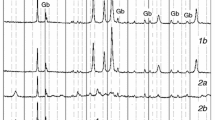Abstract
The thermal decomposition of MgCl2·6H2O (non-dried and partly dried) and the kinetics of the process were studied by DTA, TG, DTG, IR, X-ray diffraction and chemical analysis of Mg and Cl. The reactions which occurred in the course of the thermal analysis were identified as dehydration (in steps), thermal hydrolysis of MgCl2·H2O and dehydrochloridization of magnesium hydroxy chlorides. Melting of the phases MgCl2·6H2O, MgCl2·4H2O and MgCl2 was also identified in the thermal curves. Thermal weight loss continued up to 800 °C in flowing air or nitrogen, but only up to 700 °C in static air. MgO was the end-product of thermal treatment in both cases.
The kinetic parameters of the reaction, the activation energyE, pre-exponential factorA and apparent order of reactionb, were computed by several methods. The activation energy and the apparent reaction order of dehydration were found to increase with decreasing hydration number of the Mg. The dehydrochloridization process had the highest activation energy.
Zusammenfassung
Die thermische Zersetzung von MgCl2·6H2O (nicht und teilweise getrocknet) und die Kinetik dieses Prozesses wurden mittels DTA, TG, DTG, IR, Röntgendiffraktometrie und chemischer Analyse von Mg und Cl untersucht. Die im Verlaufe der thermischen Analyse vor sich gehenden Reaktionen sind Dehydratisierung (in Schritten), thermische Hydrolyse von MgCl2·H2O und Chlorwasserstoffaustritt aus Magnesiumhydroxychloriden. Das Schmelzen der Phasen MgCl2·6H2O, MgCl2·4H2O und MgCl2 ist in den thermischen Kurven ebenfalls zu erkennen. Im Luft- und Stickstoffstrom erfolgt ein Gewichtsverlust bis 800 °C, in statischer Luftatmosphäre dagegen nur bis 700 °C. MgO war in beiden Fällen Endprodukt der thermischen Behandlung. Die kinetischen Parameter der Reaktion (AktivierungsenergieE, präexponentieller FaktorA, scheinbare Reaktionsordnungb) wurden nach verschiedenen Methoden berechnet. Aktivierungsenergie und scheinbare Reaktionsordnung der Dehydratisierung nehmen mit abnehmendem Hydratationsgrad des Mg zu. Die Chlorwasserstoffabspaltung erfordert die höchste Aktivierungsenergie.
Резюме
Методом ДТА, ТГ, ДТГ, ИК спектроскопии, рентгеноструктурно го анализа и химического анализа было изучено термиче ское разложение гексагид рата хлористого магн ия (влажного и частично в ысушенного) и кинетик а процесса его разложения. Были и дентифицированы следующие реакции: де гидратация (ступенча тая), термический гидроли з моногидрата хлорида магния и деги дрохлорирование осн овной соли магния. На термически х кривых идентифицированы те мпературы плавления гексагидрата, тетраг идрата хлорида магни я и безводной соли. В дина мической атмосфере в оздуха и азота термическая по теря веса продолжалась до темп ературы 800 °C, тогда как в статической атмосфе ре воздуха-до 700 °C. B обоих случаях конечн ым продуктом разложе ния являлась окись магния. Несколь кими методами были расчит аны энергия активаци и, предэкспоненциальн ый множитель и кажущи йся порядок реакции. Уста новлено, что энергия а ктивации и кажущийся порядок ре акции дегидратации увелич иваются с уменьшение м числа гидратации магния. Пр оцесс дегидрохлорир ования имел наиболее высоко е значение энергии ак тивации.
Similar content being viewed by others
References
É. Buzágh-Gere, S. Gál and J. Simon, in H. G. Wiedemann “Thermal Analysis.” Proc. III ICTA, 1971, Vol. 2, Birkhauser Verlag, Basel 1972, p. 635.
É. Buzágh-Gere, S. Gál and J. Simon, Z. Anorg. Allg. Chem., 400 (1973) 37.
É. Buzágh-Gere, S. Gál and J. Simon, Hungarian Sci. Inst., 28 (1973) 25.
K. Heide and H. J. Eichhorn, J. Thermal Anal., 7 (1975) 397.
D. Petzold and R. Naumann, J. Thermal Anal., 19 (1980) 25.
T. J. Gardner and G. L. Messing, Thermochim. Acta, 78 (1984) 17 and F. H. Herbstein, M. Kapon and A. Weisman, Isr. J. Chem., 22 (1982) 207.
Y. Kato and K. Tachiki, J. Soc. Chem. Ind. Japan Suppl., 31B (1928) 104.
G. Grube and W. Brauning, Z. Elektrochem. Angew. Phys. Chem., 44 (1938) 134.
L. G. Berg and N. P. Burmistrova, Zh. Neorgan. Khim., 5 (1960) 676.
L. G. Berg, Ch. II in R. C. Mackenzie “Differential Thermal Analysis”, Vol. 1, Academic N.Y. 1970, p. 355.
S. Shoval and S. Yariv, Thermochim. Acta, 92 (1985) 819.
R. C. Weast and M. J. Astle, eds., CRC Handbook of Chemistry and Physics, 1979.
E. S. Freeman and B. J. Carroll, Phys. Chem., 62 (1958) 394.
R. Chen and Y. Kirsh, “Analysis of Thermally Stimulated Processes;” Pergamon, Oxford, 1981
É. Buzágh-Gere, J. Simon and S. Gál, Z. Anal. Chem., 264 (1973) 392.
S. Shoval, Y. Yariv, Y. Kirsh and H. Peled, Thermochim. Acta, 109 (1986) 207.
Author information
Authors and Affiliations
Additional information
The authors express their appreciation to Dr. Jacob Nathan and Mr. Yoetz Deutch from th Geological Survey, Jerusalem, for the use of the thermal analysis instrument and for useful discussion, and to Mrs. Sarah Erlich from the same institute, for the chemical analysis. The financial support by Everyman's University, Tel-Aviv, and by the Hebrew University of Jerusalem is acknowledged.
Rights and permissions
About this article
Cite this article
Kirsh, Y., Yariv, S. & Shoval, S. Kinetic analysis of thermal dehydration and hydrolysis of MgCl2·6H2O by DTA and TG. Journal of Thermal Analysis 32, 393–408 (1987). https://doi.org/10.1007/BF01912692
Received:
Revised:
Issue Date:
DOI: https://doi.org/10.1007/BF01912692




